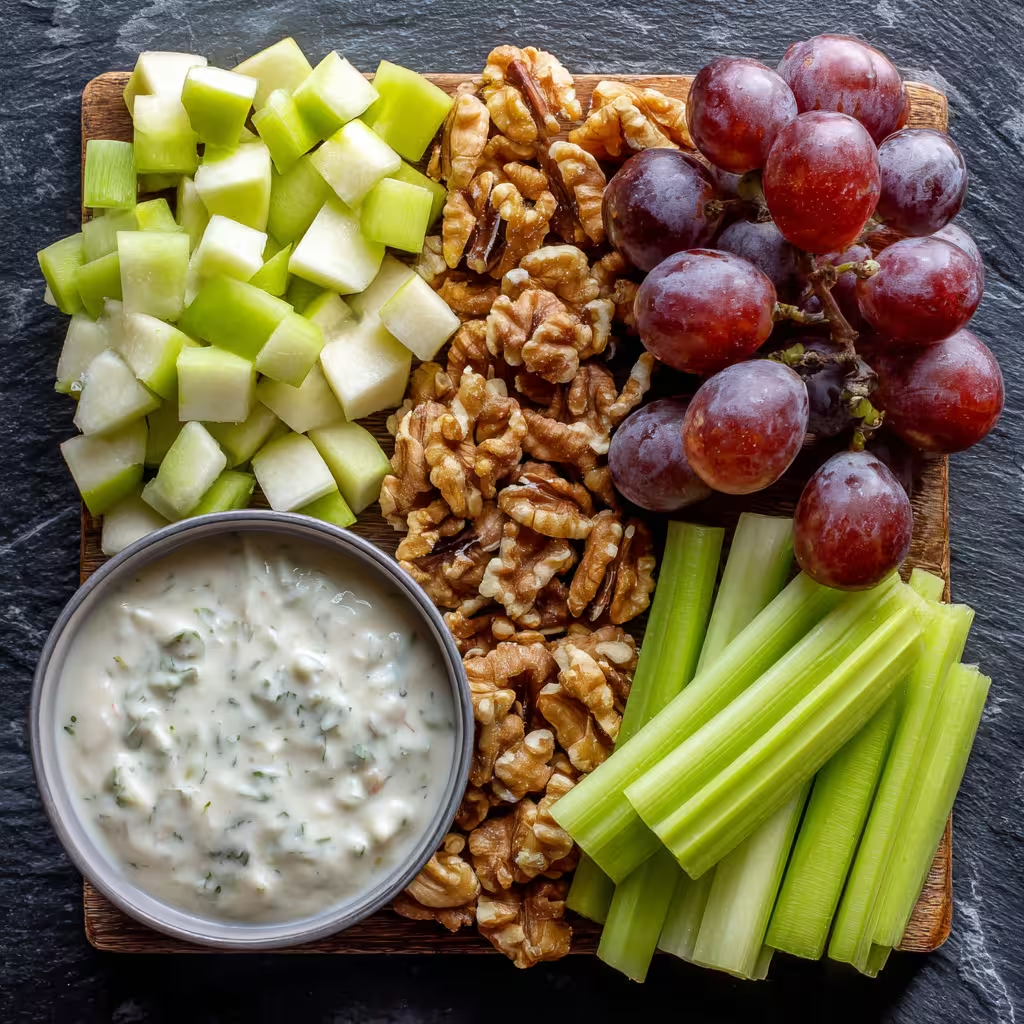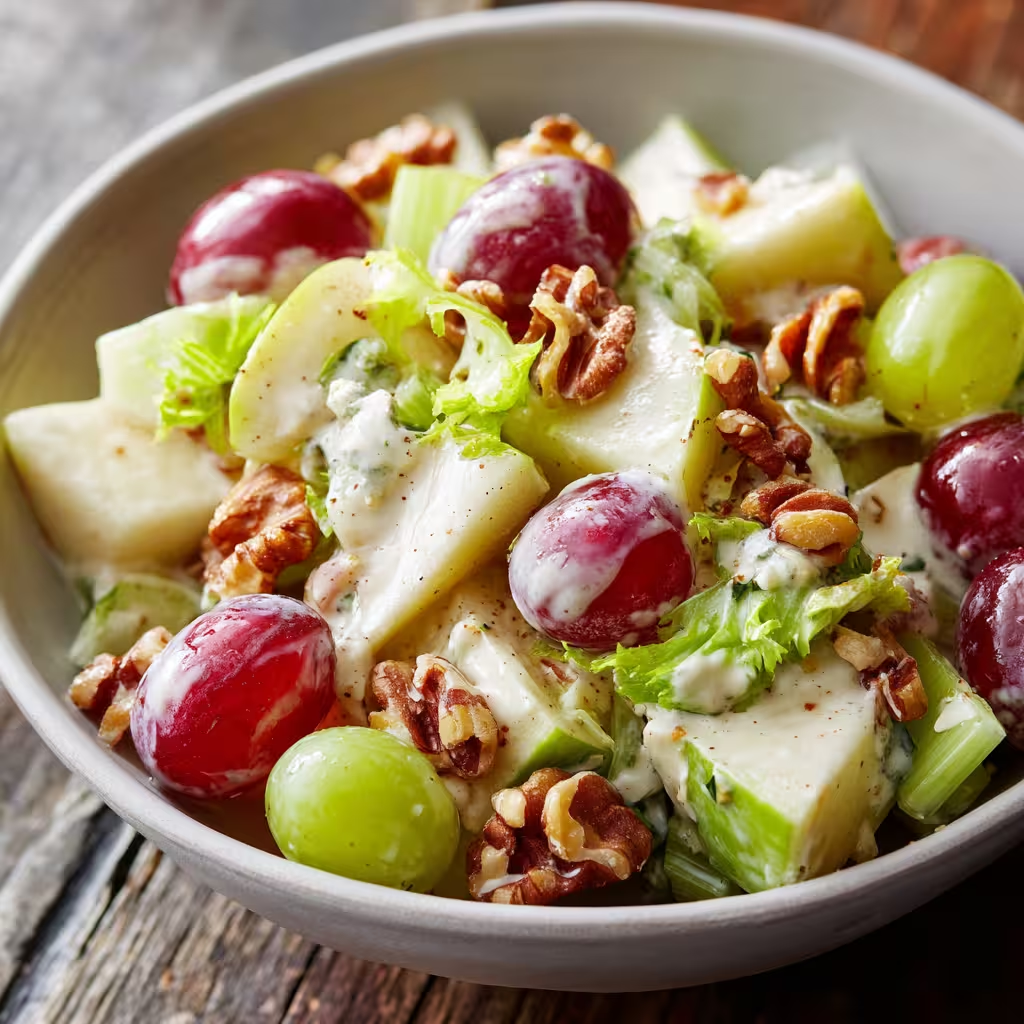A crisp, refreshing salad that blends sweet and savory flavors, the Classic Waldorf Salad dates back to its debut at New York’s Waldorf Hotel in 1896. In this guide, you’ll discover where the recipe began, why it endures today, and how to make it yourself. We’ll cover the essential ingredients, step‑by‑step instructions, smart tips for variations, and serving ideas that pair perfectly with your meal. Along the way, you’ll learn about health benefits, creative twists, and the story behind every crunchy bite. Let’s dive into the world of the Classic Waldorf Salad—where history meets homemade comfort.
Exploring the Foundations of the Classic Waldorf Salad
The Classic Waldorf Salad remains a beloved dish because it balances crisp textures with bright flavors. Originally created in the late 19th century, this salad has kept its place on tables from formal banquets to casual lunches. Today, home cooks still appreciate its simplicity and adaptability.
Origins of the Classic Waldorf Salad
The Classic Waldorf Salad first appeared at the Waldorf Hotel in New York City in 1896. A chef there combined apples, celery, and mayonnaise for wealthy guests seeking light fare. Moreover, this salad quickly caught on because it showcased fresh produce in an elegant, approachable way.
Key Ingredients You Need
To recreate the classic version, you’ll need tart apples (Granny Smith works best), crisp celery stalks, and chopped walnuts for crunch. Additionally, a creamy dressing—usually mayonnaise thinned with a touch of lemon juice—ties everything together. For extra freshness, some cooks stir in halved red grapes or a sprinkle of fresh parsley.
Tip: If you enjoy classic salads like this one, you might also like our Apple Carrot Slaw, which uses a similar sweet‑and‑savory approach.
When shopping, choose firm apples and celery with bright green leaves. This ensures each bite of your Classic Waldorf Salad pops with flavor and texture. For more inspiration, explore our full collection of Salad Recipes to see other easy, family‑friendly ideas.
Mastering Your Waldorf Salad Recipe
Once you understand the bones of the Classic Waldorf Salad, it’s time to assemble and dress your creation. This Waldorf salad recipe brings together crisp apples, celery, and nuts in a bowl, then coats them in a tangy, creamy dressing that highlights each ingredient.

Crafting the Perfect Dressing
To make the signature Waldorf salad recipe dressing, start with high‑quality mayonnaise—about ½ cup for four servings. Whisk in 1–2 tablespoons of freshly squeezed lemon juice to balance the richness and prevent apples from browning. For extra brightness, stir in a teaspoon of Dijon mustard and a pinch of salt and pepper. Taste and adjust: if you prefer a lighter dressing, fold in a tablespoon of plain yogurt or sour cream.
Pro tip: For a dairy‑free twist, substitute Greek yogurt or vegan mayo.
Step‑by‑Step Assembly
-
Chill your bowl and utensils. Keeping everything cold helps the dressing cling.
-
Toss the apples and celery. Combine 2 cups of chopped apples with 1 cup of sliced celery in the chilled bowl.
-
Add walnuts and grapes. Stir in ½ cup of toasted walnuts and ¾ cup of halved red grapes for sweetness.
-
Fold in the dressing. Gently mix until every piece shines with the creamy sauce—don’t overmix or you’ll bruise the fruit.
-
Garnish and serve. Sprinkle chopped parsley or a few extra walnut pieces on top before plating.
Pair this Waldorf salad recipe with your favorite protein or side. It complements grilled chicken beautifully—try it alongside our Chicken Caesar Salad for a refreshing lunch—or pack it for outdoor gatherings with other Picnic Recipes.
Creative Variations and Nutritional Insights
Flavorful Twists to Elevate Your Classic Waldorf Salad
You can easily customize the Classic Waldorf Salad to suit seasonal produce or bold flavor profiles. For instance, swap red grapes for pomegranate arils to add jewel‑like color and a tart pop in every bite. Alternatively, toss in chopped fresh pears or diced mango for a tropical spin that complements the crunchy apples and celery. Moreover, you might stir in a tablespoon of honey or maple syrup to the dressing when you crave a touch more sweetness.
For an elegant presentation, serve your Waldorf salad recipe in individual lettuce cups—iceberg or butter lettuce works beautifully. If you love nuts, experiment with pecans or slivered almonds instead of walnuts; each variety brings its own aroma and texture. When you’re ready for more fresh ideas, check out our Fruit Salad Recipes for inspiration on combining fruits in inventive ways.
Health Benefits and Nutritious Swaps
Beyond its delightful taste, the Classic Waldorf Salad offers several health advantages. Apples and celery provide dietary fiber that supports digestion, while grapes contribute antioxidants and vitamins. Walnuts add heart‑healthy omega‑3 fatty acids and plant‑based protein. To lighten up the dressing without sacrificing creaminess, replace half of the mayonnaise with plain Greek yogurt—this swap boosts calcium and protein and reduces fat content.
If you follow a dairy‑free diet, choose coconut‑milk yogurt or a plant‑based mayo for similar texture. Additionally, you can fold in grated carrots or finely chopped kale for extra vitamins and minerals without altering the signature crunch. For a low‑carb version, simply omit the grapes and swap apples for cucumber slices; you’ll still enjoy that crisp contrast in flavors. For more wholesome salad options, explore our collection of Healthy Salad Recipes that celebrate vibrant ingredients and smart substitutions
Serving Suggestions and Pairing Ideas
Perfect Pairings for Your Classic Waldorf Salad
When it comes to serving your Classic Waldorf Salad, balance is key. For a light lunch, plate it alongside a crusty baguette or warm ciabatta—its soft crumb contrasts beautifully with the salad’s crunch. Alternatively, serve the salad over a bed of butter lettuce for a more substantial starter. For heartier fare, pair the salad with grilled salmon or roasted chicken; their savory richness complements the salad’s sweet‑and‑tangy notes. If you’re planning a buffet or casual gathering, offer the Classic Waldorf Salad in individual endive leaves or small cups for easy, elegant finger food. To explore more crowd‑pleasing starters, check out our Vegetarian Recipes for simple, meat‑free ideas that work alongside this timeless salad.
Creative Serving Styles and Season-Inspired Twists
Seasonal accents bring new life to the Classic Waldorf Salad. In autumn, swap grapes for dried cranberries and stir in roasted butternut squash cubes for warm color. During spring, garnish with fresh mint leaves and peas for a garden‑fresh twist. For festive occasions, serve the salad in hollowed‑out apple halves—just core and fill each half with your dressed salad before topping with walnut halves. If you prefer a colorful presentation, layer the salad ingredients in a clear glass trifle dish to showcase apples, celery, grapes, and nuts. Finally, pair your Waldorf salad recipe with light soups—our Dinner Recipes section has brothy minestrone or chilled gazpacho that make excellent companions without overpowering the salad’s delicate flavors.

Origins of the Classic Waldorf Salad
The Classic Waldorf Salad first appeared at the Waldorf Hotel in New York City in 1896. A chef there combined apples, celery, and mayonnaise for wealthy guests seeking light fare. Moreover, this salad quickly caught on because it showcased fresh produce in an elegant, approachable way. You can read more about its history on Wikipedia’s Waldorf salad page. (https://en.wikipedia.org/wiki/Waldorf_salad)
Health Benefits and Nutritious Swaps
Beyond its delightful taste, the Classic Waldorf Salad offers several health advantages. Apples and celery provide dietary fiber that supports digestion, while grapes contribute antioxidants and vitamins. Walnuts add heart‑healthy omega‑3 fatty acids and plant‑based protein. For detailed nutrient breakdowns, check the USDA’s FoodData Central. (https://fdc.nal.usda.gov) To lighten up the dressing without sacrificing creaminess, replace half of the mayonnaise with plain Greek yogurt—this swap boosts calcium and protein and reduces fat content. If you follow a dairy‑free diet, choose coconut‑milk yogurt or a plant‑based mayo for similar texture. Additionally, you can fold in grated carrots or finely chopped kale for extra vitamins and minerals without altering the signature crunch.
FAQ
What is Classic Waldorf Salad?
Classic Waldorf Salad is a crisp, refreshing mixture of chopped apples, celery, red grapes, and toasted walnuts bound in a creamy mayonnaise–lemon dressing. It was first served in 1896 at New York’s Waldorf Hotel and remains beloved for its sweet‑and‑savory contrast and easy preparation.
What was the original recipe for Waldorfsalat?
The original Waldorfsalat, created by the Waldorf Hotel chef in 1896, included just apples, celery, and mayonnaise. Later versions often added walnuts and grapes for extra crunch and sweetness, evolving into the version we know today.
Is a Waldorf Salad healthy?
Yes. Apples and celery provide dietary fiber and vitamins, grapes add antioxidants, and walnuts supply heart‑healthy omega‑3s and protein. By swapping half the mayo for Greek yogurt, you can reduce fat and boost protein further.
What goes well with Waldorf Salad?
Classic Waldorf Salad pairs beautifully with grilled or roasted proteins—think chicken or salmon—and crusty breads. It also works as a vibrant buffet item, served in lettuce cups or alongside light soups like gazpacho.
From its storied origins at the Waldorf Hotel to your own kitchen table, Classic Waldorf Salad delivers a timeless blend of crunch and creaminess. With just a handful of simple ingredients—apples, celery, grapes, and walnuts—plus a tangy dressing, you get a dish that’s as versatile as it is flavorful. Whether you stick to the original or try one of the many variations, this salad shines year‑round. Serve it as a light lunch, an elegant starter, or a side that elevates any meal. Ready for your next salad adventure? Gather your ingredients, toss on that dressing, and enjoy the perfect combination of history and home‑style comfort.
PrintClassic Waldorf Salad: A Delightful Crunchy Apple and Celery Masterpiece
- Total Time: 15 mins
- Yield: 4 servings 1x
- Diet: Vegetarian
Description
Classic Waldorf Salad blends crisp apples, celery, grapes, and walnuts in a creamy dressing—perfect as a light lunch or side dish.
Ingredients
2 cups chopped tart apples (Granny Smith)
1 cup sliced celery
½ cup halved red grapes
½ cup toasted walnuts
½ cup mayonnaise
1–2 tbsp fresh lemon juice
1 tsp Dijon mustard
Salt and pepper to taste
Optional: plain Greek yogurt to lighten dressing
Optional: fresh parsley for garnish
Instructions
1. Chill a large mixing bowl and utensils
2. Combine apples and celery in the chilled bowl
3. Add grapes and toasted walnuts to the bowl
4. In a separate bowl, whisk together mayonnaise, lemon juice, mustard, salt, and pepper
5. Fold dressing into the fruit and nut mixture gently
6. Garnish with parsley and serve immediately
Notes
Use tart apples to prevent browning.
Toast nuts for extra flavor.
Serve chilled.
- Prep Time: 15 mins
- Cook Time: 0 mins
- Category: Salad
- Method: No-cook
- Cuisine: American
Nutrition
- Serving Size: 1 cup
- Calories: 200
- Sugar: 12g
- Sodium: 150mg
- Fat: 15g
- Saturated Fat: 2g
- Unsaturated Fat: 10g
- Trans Fat: 0g
- Carbohydrates: 18g
- Fiber: 3g
- Protein: 3g
- Cholesterol: 5mg
Keywords: Classic Waldorf Salad, Waldorf salad recipe

